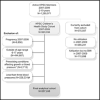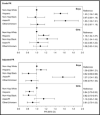The prevalence of primary pediatric prehypertension and hypertension in a real-world managed care system
- PMID: 24283596
- PMCID: PMC3844934
- DOI: 10.1111/jch.12173
The prevalence of primary pediatric prehypertension and hypertension in a real-world managed care system
Abstract
To assess the burden associated with hypertension, reliable estimates for the prevalence of pediatric hypertension are vital. For this cross-sectional study of 237,248 youths aged 6 to 17 years without indication of secondary hypertension, blood pressure (BP) was classified according to age, sex, and height using standards from the Fourth Report on the Diagnosis, Evaluation, and Treatment of High Blood Pressure in Children and Adolescents as prehypertension with at least 1 BP ≥90th percentile and as hypertension with 3 BPs ≥95th percentile. The prevalence of prehypertension and hypertension were 31.4% and 2.1%, respectively. An additional 21.4% had either 1 (16.6%) or 2 (4.8%) BPs ≥95th percentile. Based on this large population-based study using routinely measured BP from clinical care, a remarkable proportion of youth (6.9%) has hypertension or nearly meets the definition of hypertension with 2 documented BPs in the hypertensive range.
©2013 Wiley Periodicals, Inc.
Figures


References
-
- Ezzati M, Lopez AD, Rodgers A, et al. Selected major risk factors and global and regional burden of disease. Lancet. 2002;360:1347–1360. - PubMed
-
- Kearney PM, Whelton M, Reynolds K, et al. Global burden of hypertension: analysis of worldwide data. Lancet. 2005;365:217–223. - PubMed
-
- Daniels SR, Kimball TR, Morrison JA, et al. Effect of lean body mass, fat mass, blood pressure, and sexual maturation on left ventricular mass in children and adolescents. Statistical, biological, and clinical significance. Circulation. 1995;92:3249–3254. - PubMed
Publication types
MeSH terms
Grants and funding
LinkOut - more resources
Full Text Sources
Other Literature Sources
Medical

